There are many myths and mysteries about the Mooney line of
aircraft. The slick design, high speeds, affordable complexity
and luxury end of the small piston spectrum tend to make Mooney's
mysterious, desirable, ladies. Other airplanes appear more accessible
to transition into
and take best care of, the Mooneys have whispered challenges. My
goal in this article is to present the Mooney transition I went
through,
and
hopefully
debunk
some myths while highlighting the accurate positive advantages
of this vintage performance bird.
|
I purchased a 1980 Mooney M20K 231.(read about the
whole purchase process here ),
a Mooney model which carries most of the characteristics I describe
as being Mooney
Demons.Here are my thoughts about the Mooney transition,
and whether the myths became fact. By the way, prior to this
I flew Piper Archers.
As part of the transition, I took 10 hours of dual training
from a very experienced Mooney instructor, well worth it, I strongly
recommend
you do
so. My 10
hours took us through the standard air work (steep turns, stalls),
emergency procedures, and then perhaps the most important 5.5 hours
of the training, landing at 11 different airports in one day, from
high altitude airports like Lake
Tahoe to mountain top strips like
Willits, to big
sea level fields like Sacramento
Executive. |
I'll walk through it as you would take a flight, from boarding
to securing
- On the Ramp and Boarding
- Starting
- Taxi and runup
- Takeoff
- Climb
- Cruise
- Engine operation
- Decent
- Landing
- Conclusion
|
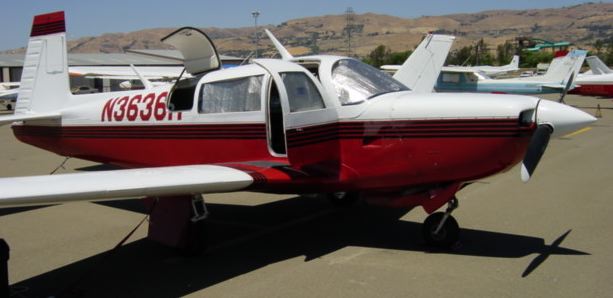
On the Ramp and boarding: One
thing that strikes you as you walk out to the Mooney for the
first (or second,
or
third)
time is that it appears tiny. Mooneys look smaller on the ramp,
something you need to get used to, since you're going to be explaining
to potential passengers that Yes, there is room in there
for you! It sits low. The retractable gear sit the airplane
lower than a Piper, and a great deal lower than a Cessna, Cirrus
and others. Looks smaller, though the (relative) same fuselage
volume has just been set down at a lower level. And the vertical
tail, straight-up-and-down, doesn't lead your eye along. Other
swept tails lead your eye, convincing you the airplane is longer.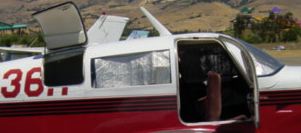
Up closer, by the right rear wing root, getting ready to climb
in. Opening the baggage door you notice that it's narrow, and
mounted high on the fuselage. It's
an up
and over load,
not a slide in. Also, the door is curved and doesn't' open
past 90 degrees, so you cannot get something straight up and
in. Be prepared to do a lot of lifting and juggling to get
things in the door.
Climb up on the wing. The 231 does not have
a helper step, so it's a stretch to step over the flap and
onto the walkway.
The doorway is narrower than many, but the door swings wide.
The upper door cutout goes deeper into the skin that, say,
a Piper, so there is a little more maneuvering room.
The seats are inches lower than the door sill, so there is
some contortions to be done to get in. And as the pilot, make darned sure
you slide your seat back fully aft when you get out, or you'll
be banging into cowl flap, vent, and throttle levers as you
worm into the seat.
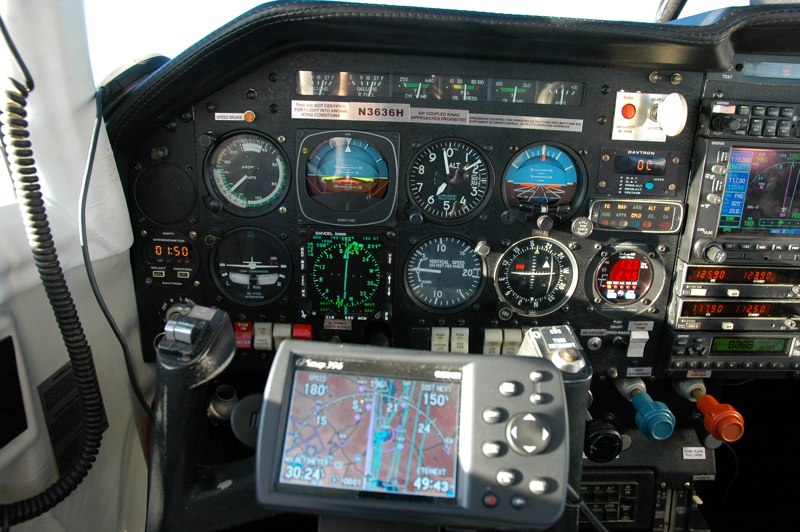
Seating position: I read about this a bit,
and it turns out to be true and something that takes some time
to get used to. The Mooney rudder pedals are further forward
than I had expected. I'm
not tall,
but
not short, and I have to have the seat almost fully forward
to be comfortable on the pedals. What this means immediately
is that you have a different view of the instrument cluster,
you have a more extreme downward view angle. I had to get used
to a new perception of the attitude indicator,for instance,
to determine straight and level.
Another issue with the further forward seat is the yoke is
much more in your lap. I'll talk about this more when talking
about flying the aircraft, but just sitting in it you realize
that your trusty kneeboard is a lot harder to write on. I'm
moving to a yoke-mounted clipboard to adapt to this.
The width of the cockpit is not the issue some have made of
it. It feels slightly wider than an Archer, and I have slightly
less interference with the passenger
Headroom is not an issue, my headset or hat has not hit the
roof. Now lets gently close the door (do not slam
it, gently close and latch) and start it up.
|
Starting:The 231 is a turbocharged fuel injected model, differently
equipped models will start differently.
There are a lot of myths about starting a turbocharged Mooney,
I read them all and held this issue (along with landing) as the
spookiest thing about transitioning to a Mooney.
Not a Problem. I had the right person show me good technique,
and I've not had any starting issues. Note it's now 2010 and I've revised my starting procedure. What I explained here in the past was good, but this is now better, and works wonderfully well.
First different thing first for those who have flown other aircraft:
Don't turn on a fuel pump. Yes, there are two fuel pump switches,
one
for
low
boost
and
one for
high boost. But during normal operations, from start to takeoff
to landing you do not use the fuel pumps.
Press the electric primer for the period of seconds,. there
is a chart in the POH you can follow if you want. Now, wait. I time 30 seconds from when I stop pressing the primer switch to when I engage the starter. This gives the fuel you just blew in a chance to vaporize. With this technique the engine starts near instantly, even when it's near 30 deg. F. Quickly set to
1,200 RPM, and warm up the oil going to the turbo, be ready to give it a few squirts from the primer switch as you settle it in on 1,200.
The second myth about starting, starting a hot turbo engine,
also turned out to be easy to master with the right guidance. My
transition instructor said;
What has been happening for the last 45 minutes? The fuel
injector lines running on top of the engine have been heated
by the updraft heat while this airplane has been sitting. What
does that mean? The fuel is vaporized in the lines. That's what
causes the hard starts!
Which means the key is to overcome the vaporlock. How? Shove
the throttle in, and hit the low boost pump for 10-30 seconds without cranking
the engine. You're charging the lines and (hopefully) forcing the
vapor to either exit or go back into solution. Then back to the
standard starting procedure. I used this technique after a 1/2
hours start at Lake Tahoe (6,400 ft, density altitude that day
of 8,200) and a 2 hour stop at sea level and it again works without
a hitch. I no longer worry about starting a turbo Mooney.
Everything else is standard, time to... |
Taxi and Runup: Here you may experience the long
throw to the pedals issue again if you didn't slide your
seat forward enough, since you couldn't imagine having to be that close
to the instrument panel! To steer and apply the brakes you sure
do, so stop the airplane and pull up a little more. There are rudder pedal extension kits, I had the 1.5 inch ones installed in 2007 and they help this issue.
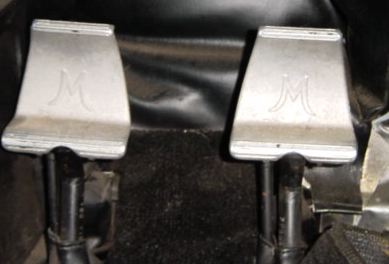
When you're taxing you get another difference, and this is Mooney
model specific. Many Mooneys, like M20k, have slightly shorter
instrument panels that many other airplanes. That means you have
a better view frontwards during taxi, which is very nice.
An issue which might just be my airplane first arises here.
The brakes are not as effective as other airplanes I've flow.
I find myself applying more pressure that I expect to have to
apply.
Steering is not too broad, but also not too tight, so watch
your turn to runup position the first few times so you don't
end up with one wheel in the grass.
Park and runup. Nothing new, time to.... |
Take off
Trim is important. And, flap are important. 10 degrees flap at
takeoff is recommended in the POH (though not required). I've tried
a no-flap takeoff in the 231, and I prefer having the flaps down
during TO.
Onto the runway, and roll the throttle up. Acceleration in the
first third of the takeoff roll is less that I've been used to,
but once you are at 40" manifold pressure and get rolling, the
airplane accelerates rapidly. The nose wheel starts to shimmy at
about 61 KIAS, pull back with about 2 pounds of pressure to smooth
out the shimmy, then apply progressively more pressure and she lifts
right off at 64 KIAS. Very smooth initial ground-break to climb once
you've got the feel for it.
Gear up (because you're now a cool Mooney Pilot), not much change.
Take the 10 degrees of flaps up Whoa!!!!!!! Holy
Toledo does the nose want to shoot straight up when you take the
flaps in!
The POH warns you about it, but golly it sure is dramatic
when you first (and 2nd, and 3rd, and 30th) experience it. I now
have the habit of having my thumb putting in nose-down trim when
I start reaching for the flap up switch, you have to stay ahead
of the nose up. Hard to get through your head, because it is only
10
degrees of flaps, and the flaps look so small on the Mooney, long
but narrow.
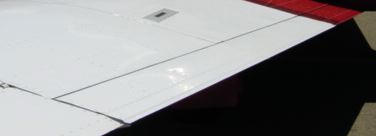
Note also that the takeoff at altitude was not much different.
I've taken off from Lake Tahoe twice, once with a density altitude
of 8,200 and once with 8,400 with no issues. Of course the turbo
is taking care of the engine in a 231, but the ground roll was
as in the book or less.
So we're.... |
Climbing: The Mooney climbs very well. In fact,
the Mooney climb confuses me.
If I trim to 90 knots, I'm getting 800 fpm. If I trim to slightly
less, a performance climb at 85 knots, I'm getting 1200-1500 fpm.
Drop the nose and climb at 100 and I'm getting 500 fpm or more.
The climb performance is much broader, and better, than I had expected,
it's actually hard because you have so many variables to pick
from. One thing I have not noticed is engine heat
problems on climb. Even at a performance climb regime the engine
stays comfortably in the green temperature band. Don't ignore it,
but it's not stressful.
This has been in 80-90 degree Fahrenheit weather, too, or at
high altitude at Tahoe. I can't wait to see how quickly I can
peg the VSI needle when it's 35 degrees.
Ready to.... |
Cruise Level off and get ready for cruise.
The airplane takes about 5 minutes to settle in to cruise, so
be prepared to tweak your engine and prop settings for a little
bit. Then, first real difference, is pick you speed. At 11,500
I've had comfortable cruise speeds (meaning no excessive noise
or vibe from odd prop or throttle settings and using by-the-charts
settings) between 130 knots and 170 knots. The range of speed
you can pick from makes
a Mooney much different from an Archer, for example, where you
really just want it to go as fast as it can at 75% power. Heck,
I've pushed rented Archer II's at 75% making only 120 knots and burning
9 gph. Setting the Mooney to 130 knots drops fuel consumption
to 6.5-7 gph
So
decide what you want to do, go fast or go still-fast-but-not-so-fast
and go. Now that we've gone up and leveled off, lets talk about... |
Engine Operation: This area really relates
to turbo models of Mooneys, like my 231.
First thing to consider is; If you got an airplane with a turbo,
you'd better fly up high to make it worth it. If your regular
flying regime is below 12,000 ft, you don't need, and shouldn't
get, a turbo equipped Mooney, it's just a waste of weight and
another potential failure point. Read more about that in my Buying
a Plane notes.
If you do need and get a turbo equipped Mooney, there is slightly
more workload. But you'll find it's easy to understand, the differences
make sense, so it's easy to incorporate into your regular operations.
Take-off and going around are the only times when you'll even
think hard about it. A turbo'd Mooney can't be pushed full throttle
(as you've been trained in normally aspirated airplanes) in those
situations, you'll spin the turbo too fast and over pressurize
your engine. Which will make something break eventually.
| This means a good look at the manifold pressure gauge on
a normal takeoff |
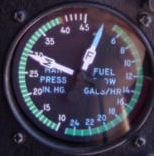 |
and getting a good feel for how much extra is left
in the throttle at max allowed manifold pressure. In my 231,
for example, the maximum allowable manifold pressure is 40 inches,
and that leaves almost 1/4 of total travel still left in the
throttle at sea level. Not hard, but you do have to spend that
extra time on the takeoff roll to look at the MP gauge. Doing
a static power-up doesn't really help, as you being the roll
the manifold pressure will change so you have to look anyway.
Go-arounds: So what does that mean during a go-around when your
hands are really busy getting the heck away from the ground,
and looking to the side at the MP gauge and doing finicky, precise,
throttle movements could put you at risk of losing control. Relax! First,
the POH gives you a little bit of flexibility, most turbocharged
engines can take some overboost. The 1980 231 can handle a transitory
manifold pressure of up to 43 inches for less than ten seconds.
Sounds too short? No, that's about the time it takes to settle
into the climb phase of a go-around, so even if you do slam the
throttle forward on a go-around you will probably un-boost before
it becomes an issue. Second, after a few flights you have a feel
for where the throttle is, anyway, and you probably won't push
the throttle full in anyway, so the max you'll overboost may
be a half-inch, which you can quickly fix.
Once you're in the air, you can drive yourself crazy if you
try and fix manifold pressure settings quickly. The key in a
turbo'd Mooney is: Make small adjustments, and let it settle
out. Wait at least 10 seconds to see the result of your throttle
adjustment before you make another one.
Bootstrapping.
Some turbo'd aircraft experience fluctuations in manifold
pressure that makes them hard to coax into cruise, commonly
referred to as bootstrapping. You can find better explanations
elsewhere on the Web, but basically some aircraft have to be
managed carefully to insure that any altitude change doesn't
result in a manifold pressure change which causes a power change
which causes an altitude change which causes a manifold pressure
change which causes a power change which causes an altitude
change which....you get the idea. I have not found my 231
to be susceptible to bootstrapping. I think it's because the
damned thing takes so long to settle in to a new power setting
that it can't react fast enough to transitory pressure changes. Admittedly, I have a Merlyn automatic wastegate which also makes bootstrapping more unlikely.
Engine temps: All my flights over one
hour duration are at 15,000 ft or above, with my preferred
altitude being 17,000 ft. and I
have not noticed particular issues with high altitude heat-shedding.
17k and outside air temp of 0 C (which is warm at that altitude)
results in temps that are in the upper half of the green bands,
but still well away from the red or yellow. I've also taken her up to ceiling going East, 23,000 ft., but rarely, just to avoid weather. Up that high the engine does teeter on the edge of the yellow, even with a -25 dC external temp reading, so be very mindful above 20,000 ft.
Leaning: I lean by the POH, which is rich-of-peak. Others run
lean-of-peak. You choose. I have run my engine LOP to see if it could handle it smoothly, and it can. |
Control The myths say Mooneys are heavy at the
controls. My experience indicates, yeah, they are. Takes some effort
to yank the yoke over, takes a lot of effort to push the nose up
and down out of the trimmed position.
Roll is heavy to start, and once it starts it wants to continue,
so be ready to neutralize almost as soon as you move into a maneuver.
That can catch you a little off-guard the first few times since
you had to throw so much energy into it to start the roll that
it's a little disconcerting to have to catch it so quickly.
Pitch, learn to use that trim switch. I've stopped using the
yoke for most pitch movements after the wheels leave the ground
until they touch back down again, it's fly by trim. And in cruise
flight I switch from using the
trim switch to using the trim wheel, because you want to make very
very small trim adjustments when you're settling into cruise.
This isn't bad, by the way. The heaviness of the controls
means it is a very stable cruise platform. I've gone through some
moderate turbulence and she stays rock-solid in pitch and roll.
Another indication of this is in stall recovery.
First, damn, it's very very hard to stall this airplane. Second,
once you do stall it do any one thing right and she pops
out of the stall. Bump the throttle up a little, she pops out of
the stall. Drop the nose an inch, she pops out of the stall. On
my initial two stalls my recovery technique was horrible, but the
airplane
broke
the
stall
in seconds
anyway.
I'm not implying that the airplane isn't fun to fly. It is,
and you can crank her over on a wingtip and have some fun. But
it is heavier to move that others.
With the full forward seating position, the yoke is more in
your lap than on other airplanes, and this takes a little getting
used to. Your pivot point for your left arm for roll is different,
adjust. Pulling back on the yoke you're starting with your arm
almost at 90 degrees at the elbow, vs. stretched out somewhat
in other airplanes, so you might find you need more muscle to
pull it back.
A little later note here: I've started sliding my seat a notch
or two back when I enter cruise. I don't need to reach the toe
brakes anymore, and two notches back gives me more room for my
kneeboard and yoke, and gives me a more neutral view of the instrument
panel. I still have excellent rudder control a little further
back.
Enjoying the ride
So how is the ride? Pretty great!
The visibility is excellent. I mentioned the lower instrument
panel, forward visibility is very good. The view from the pilot
and co-pilot window is better that a Piper, feels like you're
a little further around the curve of the fuselage. The
wing root is also further back relative to the pilot window and
position, so you can see more directly down. I can actually see
airports the GPS says I'm flying directly over. The rear passenger
windows are also very big, and you can see much farther to the
rear quarters of the airplane in flight, I've found this really
enhances my ability to see aircraft behind me when I make a turn
or in the pattern.
Noise: Probably an issue, but fixable. The Mooney I have has
an inflatable door seal, and the door seal really quiets the
cabin down. When I have forgotten to inflate the door seal the
cabin has been quite loud (even with my Bose X noise cancellers)
so I suspect a non-sealed cabin is noisier than a Piper/Cirrus.
Body comfort: The first thing my partner said when
we sat in the airplane before we bought it was "Wow,
this legroom is great!" and that continues to be true.
You have more legroom in a Mooney than any other airplane I've
ever ridden/flown, and your passengers will appreciate it. My
1980 has stock, untouched seats and they still feel very comfortable.
The longest I've flow the Mooney at one sitting is 4 hours, but
in that time I found no discomfort hotspots.
Bounce and jerk: Again, the Mooney is a very stable platform.
It smoothes out the turbulence that might make another airplane
uncomfortable. I've encountered severe turbulence once, departing North Las Vegas airport when the winds at 6,000 ft. were 65 knots and bubbling all over the mountain ridges. Very rough ride, with my head hitting the roof of the airplane. But I never felt the airplane was out of control (I may have been out of control of it), very stable even when it was being bounced all the heck over.
Crusing is over, time to.... |
Decent. The entire internet is paranoid about
the decent and shock cooling of a Mooney, particularly
a turbocharged Mooney.
Before we get into the realities, a little rant: As a former
aerospace engineer and a damned good mechanic before that, what
most
people
are
referring to as shock cooling is a very questionable
phenomena as described. i.e., y'all have not idea what you're
talking about,
do some reading and get some practical experience in materials,
engines, heat exchange, and common sense, before you start
flapping your yaps.
Until then shut up about topics you obviously
only have half a clue about,
like shock
cooling,
since your only goal is obviously to panic people who don't
understand with expositions of your great knowledge. You're
actually putting those poor folks at greater risk since they
may hesitate when they need to do the right thing for safety of
flight because they are terrified of shock cooling.
For those folks who are just flying their Mooney's, relax.
You are not going to cause irreparable damage to your engine
by reducing
power
at
the top
of a decent.
Just use good common sense, and think of this as an engine
longevity extender, not something mysterious.
Simple enough: When it's time to descend you don't slam the
throttle closed, you reduce speed slowly to insure that all the
parts of the engine, and in some Mooney's cases particularly
the turbocharger, cool evenly and at a relatively gradual rate
to insure the greatest engine life.
The Mooney transition means that you have to be a little more
aware, well, a lot more aware, of when you need to start your decent,
plan to start quite a bit further out than you would in other
airplanes.
The
things
we buy a Mooney for, like speed and speed mean
that you are (1) going to cover a lot more ground as you descend
and (2) are going to have a shallower decent rate unless you chop
the engine abruptly. Also, if you're flying a turbo,you'll find
yourself regularly flying above 10,000 ft., since the engine will
keep performing
all the
way up. I've added about 5,000 ft to my regular cruise altitudes
over Pipers, and that means 5,000 additional feet to descend, and I'm
traveling 30-50 knots faster, so I have to add 10-15 more miles
to my decent profile to descend at an ear-comfortable 500 fpm.
It's 2012 now, and I want to add something else here that's been true the whole time but I haven't explicitly mentioned. This airplane does not want to slow down. The hardest thing I have to do when I'm on my typical flight to Boise, descending out of 17,000 ft. for the 2,800 ft. msl airport is slow this baby down. Pulling the throttle back will get you down to 150 knots pretty quickly. But at that point she does not want to go slower. Basically I'm back on the throttle to 15-17 inches of MP with a bunch of nose-up trim to get down to my gear speed of 130 knots. She just does not want to stop flying.
Once the gear is down it's a little easier to slow more, but even then it's a challenge to slow. Be prepared.
Plan the decent's and watch your temps. My transition trainer,and
the POH, suggest reducing the prop RPM to lowest governable during
some portions of the decent, this tends to lug the engine, which
keeps the engine cooling more slowly and keeps final temp above
minimum. Drop your manifold pressure to descend, reduce prop speed
to keep the heat up, and it works out well.
Of course, you can take the cheaters way like I did and get
speed brakes installed. Precise
Flight speed brakes take a 400
fpm decent and change it with the push of a button to a 1000 fpm
decent, while still maintaining the same engine performance.
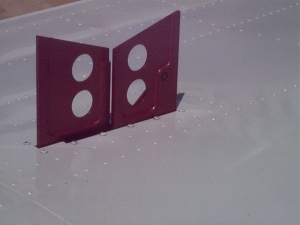
In
other words, you're descending faster but are still keeping power
levels up so you both keep the engine warm and keep yourself
on the forward side of the power curve, giving you more flexibility
in case of emergencies. I strongly recommend the speed brakes
for
a Mooney. I've even landed with them deployed on a calm, empty
day at the airport to insure I could manage it in case of an
up failure, it was a non-event. They are very handy.
Of course, somewhere during the decent you have to... |
Land. The final huge Mooney myth is that they
are hard to land, that they will float forever.
Confirm, gear down, gear green light on
There is truth to this myth, but it's a simple fix that we learn
in any airplane we fly.airspeed on approach. Watch
your airspeed, and a Mooney lands as easily as a Piper or a Cirrus.
The book airspeeds seem to work just fine
Confirm, gear down, gear green light on
In fact, the best landing I've ever done (in 461 landings) was
in my Mooney,after 20 landings I had the airspeed drilled into
my hands and it just settles right down on the runway.
Confirm, gear down, gear green light on
Higher speed does make it float, but dang it, a Piper floats
too. What I find in the two "too high approach speed
goarounds" I've
done is that in the Mooney you're not tempted to take the high
approach into the runway, you know the beast is going to just
float and float, so you go around like you should. In a Piper
I've forced it to the ground, with ensuing bouncy bouncy. The
Mooney
float
should
make you a safer lander.
Confirm, gear down, gear green light on
Flaps: First, remember the nose-up I mentioned when you pull
the flaps up after takeoff? When you start feeding the flaps
down for landing you get the opposite, the nose starts going
down dramatically. My habit is now, similar to take off, start
rolling
the trim
nose-up, then start moving the flaps down, trim trim trim, no
hand movement of the yoke, takes care of it well. I've landed
no flaps, partial flaps, and full flaps. And full flaps with
speed brakes extended (to see how controllable it was). I don't
find the difference between 10 degrees of flaps and full, 33,
degrees of flaps to have much effect on the landing process,
others might feel differently. Just slide down 10+ degrees and
land.
Confirm, gear down, gear green light on

Confirm, gear down, gear green light on. Gear comes up, gear
gotta go down. New habit for the transition to a Mooney, check
ever 10 seconds to insure the gear is down. Turn downwind, check
gear down. Base, check gear down. Final, is the gear down? Have
your passenger ask you if the gear is down. Don't land with
the gear up! It won't actually cause as much damage as you
might think, but heck you don't want to tell
people you landed with the gear up! A mechanical failure is one
thing, but I forgot should not happen.
Over the fence, 70-75 knots, pull power back. I'm still in the
air, so I'm still controlling pitch with the trim button, not
with pressure on the yoke, roll the trim steadily back as the
runway gets closer, hand on the yoke to flare, then more trim
as she settles down. Stall horn, chirp it's down. I
open the cowl flaps as soon as that happens, just so I don't
forget.
Here again it might just be my airplane, but it might be all
Mooneys, the brakes aren't as strong as other airplanes, so you
might find yourself rolling past the taxiway exit you usually
take. My experience has been that I use less runway
to land with the Mooney, but I use more on the landing
rollout.
Another area that transition reports mention is the different
feel of the landing because of the shock disks (the black rubber
disks
in the picture above) instead of a bungee/spring (Cessna et .al.)
or oleo struts (Piper et. al.). Some report that the shock disks
rebound more strongly, causing the airplane to potentially bounce/porpoise
more easily. I have not noticed that, and again, airspeed is
the key, with the right airspeed the shock disks and landing
feel normal.
Crosswind landings appear to be a non-issue. I've landed, so
far, in a 14 knot perpendicular crosswind without noticing any
handling changes except a slight drift sideways over the runway.
Tonight, for example, the Cessna on the parallel runway kept
asking for wind updates on the crosswind while I barely (and
I mean barely ) noticed that there was a crosswind.
TImer starts for the 4-5 minute Turbo cool down, and we taxi
back to the spot.
A note on Speed.
One question that has come my way a few times since I posted this
is concern about a Mooney's speed if you have spent most of your
time in slower speed aircraft. Will the higher speeds, 30-70 knots
faster than trainers, cause me trouble?
My simple answer has been no, you'll just enjoy the
speed. But today, when someone again asked this, I thought about
it more than superficially, and there is a real reason why you
should not be overly concerned about the speed boost you'll get
in a Mooney, even if you've been putting around the sky at 111
knots in an Archer, like I was.
Let's think about speed. Where does a Mooney give you speed?
My Mooney is 65 knots faster in cruise than the Archers I learned
on. In Cruise. When you're straight
and level. When you usually have time to handle whatever ATC is
going to throw at you. That's good speed, speed that you
don't have to worry about, just use.
What is speed that you worry about? Takeoff and landing, right?
Those are generally the times when you are the most busy, and
the most likely to get behind the airplane (of course, approaches
for IFR pilots). So how does a Mooney compare with an Archer
during those critical times.
Well, I rotate my 231 at the book speed, 64 knots (well, 65
since it's easier to see). Let me look at a Piper PA-28 POH and
see what the rotation speed is...Hmmm, 52 to 65 knots. Technically
the same as the Mooney!
Well, how about landing? I usually strive for 65 knots on short
final for a greaser landing. What does the PA-28 want your speed
to be on short final? Section 4.2 Landing Final Approach
Speed (Flaps 40 degrees) 66 KIAS . Well look at that, the
PA-28 is actually a knot faster than the Mooney on landing!
It's in black and white, the speed difference in the most critical
segements of flight between my Mooney 231 and a trainer-type
Piper Archer is non-existant!
It's true, getting down to those speeds is a bit tougher because
the Mooney wing wants to keep going fast. But most of your training
will transfer, your speeds and sendse of movement across the
ground on landing, for example, will be identical in
a Mooney!
Don't worry about speed, just look forward to the 50 knots more
in cruise. |
Conclusion
Mooneys are looked at as unusual beasts with
mythic gotchas to eat you. I hope, if you're planning
to start renting or buying a Mooney, that I've covered the Mooney
myths you are worried about.
I'm very very pleased with my purchase of a Mooney. It delivers,
it actually over delivers, on the promises you have heard about,
speed, range, economy, while not being the cantankerous
pilot-eater you might be fearing. Find a good transition instructor
(I can recommend mine if you're in California), read the POH and
follow it, and treat the airplane like a precision piece of machinery,
and you will not meet the myths.
Hope this gave you some insights, please send me any feedback
C.K. Haun
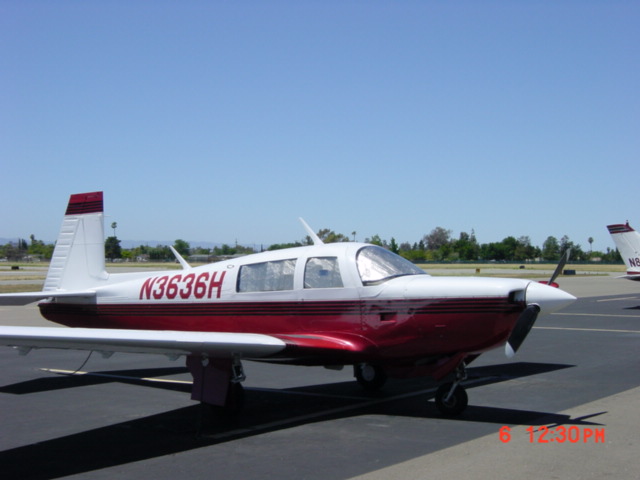
|
| |
A Year later Everything I wrote
above continues to be true, and now I've added an IFR ticket
to my certifications. That meant about 45 hours training
in 3636H (0 hours in a simulator) and I can categorically say
that a Mooney is a fine IFR platform. Couple of things to mention
about flying a Mooney IFR, in my view:
- Speeds and sink rates. Once you know your bird, establishing
and maintaining decent rates and power settings for approaches
is easy. In my case, again, adding speed brakes makes approaches
much easier and more controllable.
- Stability. Mooneys are stable. Any divergence from straight
and level that you induce while looking at an approach plate
or other distractions happens very slowly and almost predictably.
In 45 hours under the hood and real IMC my instructor never
took the controls to prevent an upset. I'll admit, part of
this is because my instructor is a very experienced
Mooney pilot himself, so he may have let some things go further
than another instructor would have.
- Instrumentation. One area that still gives me some concern.
The close-in seating position, as mentioned above, really
doesn't give me a great perspective on the Attitude Indicator.
Since you're close in you feel like you're looking down on
the instrument, instead of straight at it. This doesn't affect
horizontal awareness, but pitch up/down is harder to tell.
Seeing how many dots up or down you are pitched to takes
practice, and a weather eye on the HSI and altimeter. Part
of this also is that I have a flight director with the delta
shape to look at, instead of the more traditional wing and
dot indicator. Other instrumentation is just fine, and the
Garmin 530 makes IFR approaches almost too easy. Heck, it
tells and shows you procedure turn angles, tracks times for
you in holds, and gives you every sub-arc of a DME Arc, and
ATC will just aim you at the middle of the arc if you're
/G .
- Control. On an approach, the Mooney is very easy to track
straight (well, after 30 hours of trying). Once the needle
is centered, very small control inputs keep you centered,
and on an ILS inside the marker it's just little bits of
rudder and you're on your course.
- Getting there. The other thing about a Mooney in the IFR
system is that you've got speed. You can zip between approaches
at 140 knots while you're practicing, and on the outer segments
you can keep your speed up enough to please the most harried
controller. Then drop the gear, dirty it up, pull the throttle
back, and it's an easy 95 knots to the FAF.
- Turbulence. IFR means bumps. Mooney's handle turbulence
very very well. The stability mentioned earlier shines in
bumps.
And that's it. A great IFR platform. |
| |
|